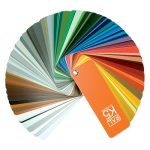The Portalp glossary
Portalp offers you its glossary for automatic doors and building security.
To understand all our technical jargon that our manufacturers, technicians, salespeople, maintenance, after-sales and sales administration services use on a daily basis.
Did we miss a term? Contact us with your request and we’ll be happy to add it to this glossary.
A
- Argon: an inert gas that replaces the air between two panes of glass. When combined with low-emissivity glass, it improves the joinery’s thermal performance.
- Apron: a light section of wall or panel between a window, the glass, and the floor.
- AS1 (Anodized Silver 1): an anodized silver process for a metal. The standard reference Portalp uses for the “satin silver” finish for its products. The aluminum was treated electrochemically so as not to oxidize and to allow it to be used without being painted.
- API: “anti-panique intégrale” or full break-out, an opening system allowing the door to open manually by applying pressure on it. These doors are installed in high-traffic areas. They provide the looks of a sliding door but can open like a door if there is a crowd movement.
- Window or door sill: an element (stone, concrete, aluminum) placed on an apron or threshold providing support for the window or the door.
- AFNOR: Agence Française pour la Normalisation
AFNOR is a services group whose goal is to ensure the competitiveness and influence of the French standards system in a context of increasing development of the EU and economic globalization.
To this end, it offers a complete range of services in four key areas:
– Standardization
– Publishing and distributing informational products
– Training and consulting
– Certification - APSAD: “Assemblée Plénière des Sociétés d’Assurances Dommage”, a French quality certification label used in construction<780/>
B
- Bay: an opening made into a wall to place a door or window.
- Casement: the mobile part of a window or glass door.
- Handle: a handle placed at mid-height to grasp and open a door.
- Two-tone: a difference in the color treatment between the outside and inside face of a door.
- Raw: a shiny appearance. The aluminum was not subjected to a chemical treatment. Raw aluminum is always painted, otherwise it oxidizes.
C
- Header: a casing in aluminum that contains the electronics and mechanics needed for the door to function.
- Chassis: it frames the glass. It is a frame made up of two (horizontal) crosspieces and two (vertical) profiles.
- CCTP: “cahier des clauses techniques particulières”. This is a contractual document that includes all the technical clauses of a public contract. It precisely describes the services in a clear manner.
- Sliding door: door that slides on a rail.
- Rail: aluminum guides with sliding seals for flexible and sectional doors.
- Crémone: a system that allows you to lock a door at several places by simply turning the handle.
- Canopy: an upper band located over a round or curved door, forming a crown in the case of a round door.
- Bending: shaping joinery to be concave to form an architectural arch.
- CE: CE marking is the visual symbol applied to a product put onto the market meaning that the product is certified to be compliant with the safety requirements applied in all member states of the European Economic Area. It’s a passport allowing a product to circulate within the entire European Union.
- CEM : “Compatibilité électromagnétique” or electromagnetic compatibility.
- CNMIS: “Comité National Malveillance Incendie Sécurité”, a French organization mandated by AFNOR to certify fire-rated doors.
- INVOLUNTARY CONTROLS: A set of opening systems that require no direct action and open the door upon certain events. These systems can often be configured (only trigger door movement on certain criteria).
For example, a radar or contact mat placed in front of a door will cause it to open automatically when a person passes in front of it. - VOLUNTARY CONTROLS: A set of opening systems triggered by a voluntary action.
For example, push buttons must be manually pressed to cause an automatic door to open. - ACCESS CONTROL: An authorization of access granted to a person. For example, a door may only open once you enter the correct access code (Digicode system) or after scanning a badge.
D
- DAS: “dispositif actionné de sécurité” or actuated safety device. A system used to connect a manual trigger control for fire detection.
- DTU: “documents techniques unifiés” or unified technical documents. They present the standards of execution and commissioning.
- Frame: a fixed frame on which the window casements or door leaves are mounted. A frame is made up of a support crossmember, a high horizontal profile, and two vertical profiles.
- Thermal loss: a loss, a reduction of heat.
- CF.PF rating: a fire resistance rating that specifies the duration of a set’s resistance to a temperature of 1000°C, the non-exposed face must not present an average temperature over 140°C.
As standard, Portalp offers doors with a CF.PF rating of an hour or a half-hour. The fire rated category is greater than the fire resistant category due to its thermal insulation.
E
- ERP: “établissements recevant du public” or buildings that are open to the public.
- EI30 or EI60: is the European classification expressed in minutes for fire doors, it expresses the fire resistance of 30 or 60 minutes.
- EMI: “Energie Mécanique Intrinsèque” or internal mechanical energy system. Current standards require implementing systems on automatic doors that do not require outside energy. The mechanical system installed is called “internal mechanical energy”. It controls the opening and closing of the door autonomously with no energy source needed to ensure that the door can move if there is a power failure, for example.
G
- Strike:a metal part that is a component of a door’s locking mechanism.
- Argon gas: an inert gas that replaces air in the space between two panes of glass. Combined with a low-emissivity glass, it improves the thermal performance of the joinery.
- Gudgeon: a metal part that acts as a support and guide for the rotation of a door, chassis, or shutter, for example.
H
- Porthole: a window with a thick pane of glass that can close hermetically, installed in a garage door.
- H.Q.E.: “haute qualité environnementale” or high environmental quality. This is an approach that seeks to limit short- and long-term impacts to the environment from construction or renovation works. General contractors have better control over the act of construction by structuring their objectives around fourteen targets.
- Jambs:
I
- Spacer bar (see also warm edge) : bars located at the edge of each pane of glass situated between the two layers of glass. These bars have a section that varies according to the thickness of the space of air in the insulating glass.
- Fanlight: a chassis, whether fixed or not, that is above the leaf or leaves that make up the door.
M
- Motorization: The act of motorizing. An electrical system that drives a movement, for example rolling or unrolling a sectional door.
O
- Opening: a mobile part such as a leaf, casement, or door as opposed to a frame.
- Oculus: a generally circular opening, generally equipped with a pane of glass.
- Late-night opening: small specific security counter dedicated to pharmacies. It allows communication and the passage of medicines while ensuring the safety of people inside the pharmacy.
P
- Pusher: swing-door operator – a mechanism installed on a door that allows the door to open by pushing on the leaf.
“PAP”: for “porte automatique piétonne”, automatic pedestrian door. - Holding profile : A metal, wooden, or PVC profile in the shape of a rail used to maintain the glass in the rabbets of the chassis.
- Door: an opening equipped with a closing system that provides a passageway inside and outside a closed space.
- Gate: The entrance to a property with a large-sized door. It allows vehicles to pass.
- Small gate: a small door placed next to an enclosure or a larger gate. It allows pedestrians to pass through.
- Renovation installation: Changing the door or another opening mechanism without changing the surrounding masonry.
Q
- Fittings: A set of accessories used for automatic and industrial doors: handles, hinges, crémones, locks, etc.
R
- RPT : rupture de pont thermique. Procédé d’assemblage sur l’ouvrant et sur le dormant aluminium qui renforce l’isolation thermique et permet d’éviter la condensation
 RAL : Nuancier international de définition des différentes teintes sur lequel tous les fabricants se sont alignés. Chaque couleur a ainsi un numéro de RAL.
RAL : Nuancier international de définition des différentes teintes sur lequel tous les fabricants se sont alignés. Chaque couleur a ainsi un numéro de RAL.
S
Threshold: The bottom horizontal member of a door frame. Anodized aluminum thresholds provide a seal.
T
- Crosspiece: a horizontal part that is part of a chassis and is assembled in the vertical profiles.
- Triple glazing: the addition of three panes of glass that make up the window. Adding this pane is intended to increase insulation performance by creating hermetically sealed spaces between the inside and outside faces of the window. More specifically, triple glazing uses the laws of physics that state that a closed space containing dry, immobile air (argon) that allows no exchanges with surrounding gases naturally acts as insulation.
- Curtain: the flexible part of a roller door that rolls up to open and rolls down to close.
U
- Ud: The coefficient for a door’s thermal insulation. The smaller the number, the better the performance.
- Ug: The thermal insulation coefficient for glass. The smaller the number, the better the performance.
V
- Sliding leaf: the mobile part of a door. It opens and closes.
- Side screen: a part of the door that doesn’t slide, it is fixed in the wall.
- Pane: a chassis of glass that acts as a closing mechanism or separation.
W
- WARM-EDGE (see also spacer bar): this is a term for certain spacer bars used in the manufacture of insulating glass. These are profiles at the edge of each pane of glass between the two layers of glass. These profiles have a section that varies according to the thickness of the space of air in the insulating glass.

 We are very sensitive to the protection of your personal data. We do not use Google Analytics in order to keep control of the data you entrust to us. This data is therefore not transferred to the United States.
We are very sensitive to the protection of your personal data. We do not use Google Analytics in order to keep control of the data you entrust to us. This data is therefore not transferred to the United States.